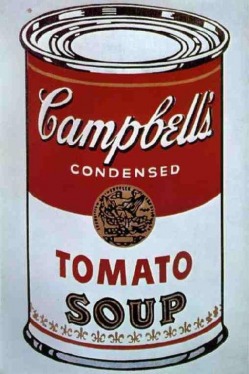It was colorful, garish, narcissistically ironic, not at all timeless - and yet, almost against my will, I began to agree that it was art. And this conclusion had nothing to do with the pieces hanging, and everything to do with me. Someone once said that learning only comes from friction. So it was that the friction between the mindset I brought to the museum and what I was confronted by brought me one revelation after another. And this was what made it art... to me. If art is that which is designed and successful in making the viewer feel, then all art is subjective.
I jotted down notes on my phone, so I’ll take you down the garden path of my stream of consciousness, and show you how I got where I arrived.
The commercialization of art. The elites once sneered at Warhol’s “sell-out aesthetic,” and my democratic sensibilities find the sneering distasteful while finding the art distasteful as well. Warhol took commercialization to another level, taking commissions from celebrities and offering bulk discounts. I have to think this art was more accessible to the masses than your average Van Gogh, however, and the affording more people this enjoyment (even if the median enjoyment per person is arguably less) can't be dismissed out of hand. That is the boon of commercialization after all; it appeals to the masses, and therefore, it must be designed in such a way to appeal to people – and therefore add value to their lives.
I wonder though whether this is at the tradeoff of not being able to stand the test of time. It’s hard to say, now, but I can’t help but think of popcorn and pop the onomatopoeic sound, and their shared characteristic of short-livedness. It has its moment of ‘shock and awe,’ and then suffers inevitable transience. It would be ironic if pop(ular) art was no longer popular, what would we call it then. I wonder whether they will still use pop art in the future to describe the art of the day, or will they have to come up with some new term altogether because we’ve confiscated this one and attached it forevermore to this era.
We are hemmed in by our language. Sometimes it seems that all that exists is the stuff we have words for. But of course that’s not the case. The world is infinite and we have art for everything else [we don’t have words for]. Art helps us store all the wordless beingness of living here. It's maybe the only way we can hold on to our tacit knowledge without transferring it to another human being. The power of it is that the dialogue we have with it is so personal, at a level without words, that when it works for us, we can't help but be convinced because we are convincing ourselves. It works best when there is that moment of surprise, then the heart’s sigh, and it pervades us – at least for that moment. No tour guide can show us, or manufacture something that’s not there, though we can fool ourselves. Each piece, therefore, cannot be universally accessible because we have to lead ourselves down the path, and not everyone will get there. Because only we can feel our response in just this way, art is always about us. It, like life, is deeply narcissistic.
What does it say about someone who puts pop, in its truest subjective sugar-transient sense, on their walls. Something that doesn’t hold real meaning, but is an ironic throwaway comment, a cliché, a cheap sarcasm. I struggle not to be dismissive…and I fail. The thing is, like much façade, no one will know. Only self-honesty would reveal the falsehood, and why do the rest of us even care. Perhaps there are lessons here. Beyond judging is not caring, and beyond not caring is empathy (I think). For those of us so quick to dismiss pop and pop culture, these are opportunities lost.
Each piece here holds little meaning for me, but there's something here in this installation as a whole. It is the things I dislike the most that provide the foil for me to think of these things, inspire this intellectual-emotional response, and yet even knowing that, I can’t find it in myself to seek out what I hate. This section on pornography here, the artist might feel, be, empowered but I can’t help but feel sad when a woman defines herself to society in such a limited way. As much as she might try to expand thinking, it's a martyrdom even if it finds a modicum of success. No matter what else you do, the heights you climb, the epithet will never go away. Once a porn star, always a porn star.
Just as writers tend to write about writers and writing, artists tend to make art about art and artists. You craft from the material you know. Some of these artists have commercialized themselves, designed a persona, the artist as art. I think this is sad as well, this constant self-consciousness, the permanent inconsistency of outside and in. It’s strange that men would take this on themselves, when they – being men – were born spared the constant and repressive watching that women must bear. Our choices are few – either we carry it until it warps us, or we struggle to first throw it off and then daily to keep it off. But the male artist, he had a choice. These personas are brittle, unsympathetic, allowing few affordances for understanding or empathy.
I can admit this is art but I would never hang these pieces on my wall. Hanging a piece on a wall is like having a tattoo on your body – it should be more than novel or pretty. It should have the depth to age with you like wine, like a spouse. And it should make you happy. Happy is a shallow word but what it represents is not shallow at all. Perhaps feeling anything is better than nothing, but we have more attractive alternatives. The hacks revert to flimsy irony, but the masters produce what we could never have thought of or made but want to.
I walk outside into the cheek-tingling cold and wish I was back inside. But the cold isn’t as numbing as it seemed and everything looks like art to me, the knit gloves, the Thames, the commercial signage. It all has the feeling of the designed. Pop Art has escaped, seeped outside.


 RSS Feed
RSS Feed